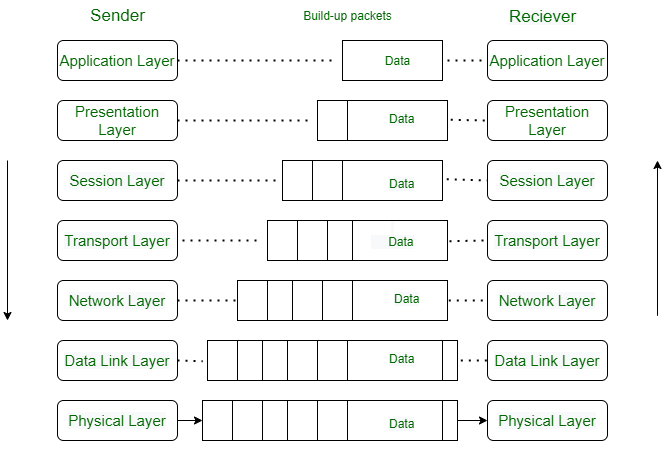CL-CY Level 2 report
1 / 3 / 2024
Task 1 - OSI
The task had following objectives:
- Learn about the OSI architecture
- The protocols, switching, routing
- Handshakes, IP addressing
The aim of this experiment was to learn about the basic structure and functioning of OSI architecture.
Skills Learned: Basic working and functioning of the OSI architecture and its components.
OSI means Open Systems Interconnection, which is a architectural model of 7 layers. It has been created and approved by ISO in 1984 and since then is being used as a model.

-
Layer 1 - Physical Layer: The lowest layer of the OSI reference model is the physical layer. It is responsible for the actual physical connection between the devices.
-
Layer 2 - Data Link Layer: The data link layer is responsible for the node-to-node delivery of the message. The main function of this layer is to make sure data transfer is error-free from one node to another, over the physical layer. When a packet arrives in a network, it is the responsibility of the DLL to transmit it to the Host using its MAC address.
-
Layer 3 - Network Layer: The network layer works for the transmission of data from one host to the other located in different networks. It also takes care of packet routing i.e. selection of the shortest path to transmit the packet, from the number of routes available.
-
Layer 4 - Transport Layer : The transport layer provides services to the application layer and takes services from the network layer. The data in the transport layer is referred to as Segments. It is responsible for the End to End Delivery of the complete message.
-
Layer 5 - Session Layer: This layer is responsible for the establishment of connection, maintenance of sessions, and authentication, and also ensures security.
-
Layer 6 - Presentation Layer : The presentation layer is also called the Translation layer. The data from the application layer is extracted here and manipulated as per the required format to transmit over the network.
-
Layer 7 - Application Layer: At the very top of the OSI Reference Model stack of layers, we find the Application layer which is implemented by the network applications.
ROUTERS: Routers are networking devices operating at layer 3 or a network layer of the OSI model. They are responsible for receiving, analysing, and forwarding data packets among the connected computer networks.
Task 2 - Serverless
The aim of this task was to learn about serverless functions and deploy one.
Skills learnt: serverless functions and its usage
Serverless are functions which are deployed on cloud. These provide more flexibility than classic server backends and scale easily when there is an overload of triggers, in this case, requests.
A serverless function was deployed on AWS Lambda in the free tier.
Code Link:Serverless Github Repository
Trigger Link: Serverless
Task 3 - Sockets
The aim of this task was to learn and implement sockets.
Skills learnt: Usage of Sockets
Sockets are a way of implementing two way connection between machines to enable realtime communication. A chat app was built and deployed using sockets.
Code Link: Sockets Github Repository
Link: Socket Chat
Task 4 - Make a Web App
The aim of the task was to get familiar with Express and use the same to build a library management app.
Skills learnt: Express and its usage
Express.js, or simply Express, is a back end web application framework for building RESTful APIs with Node. In this task, it was used to create a resource library web app.
Code Link: Github Repositry
Library Link: Express Library
Task 5 - Docker
The aim of this task was to learn the basics of docker and to implement CI/CD.
Skills learnt: Docker and CI/CD with AWS
Docker is way of deploying the code in packages. They provide platform flexibility as they run on any available platform and also reduce the latency.
AWS,
s Code Pipeline and Code Builder were used to implement continuous integration and deployment of the code pushed into the repository.
Docker Application Link: Daily Catnip
CI/CD Map:AWS Console
Task 6 - Docker file spyware
The aim of this task was to learn the basics of Docker and how it can used to deploy spywares.
Skills learnt: Basics of Docker and spywares
Spywares are softwares or just a simple script which is used to gather intelligence and spy on machines. Docker is a very effective way of deploying spywares as they are platform independent and can run on any machines.
Here is a spyware built with python and node js.
Github Repository Link: Docker Spyware
Task 7 - Webscraping and Automation
The aim of this task was to implement webscraping and to do automation based on it.
Skills Learnt: Webscraping and automation using Selenium and Beautiful Soup.
Webscraping is an important to gather the necessary data over the web and also to filter out the streams of data flowing through the system of internet.
Automation, on the other hand, help the system go smoothly as it helps with testing and also eliminates all the simple labor work.
An automated instagram-based automation was done using Selenium with Python.
Github Repository: Insta Webscrape
